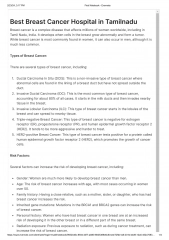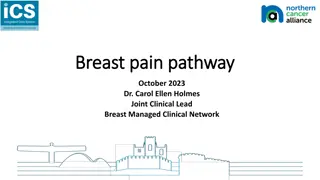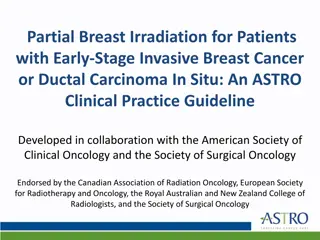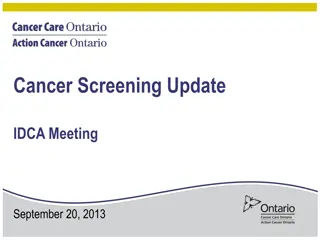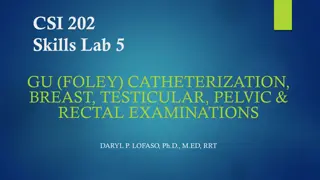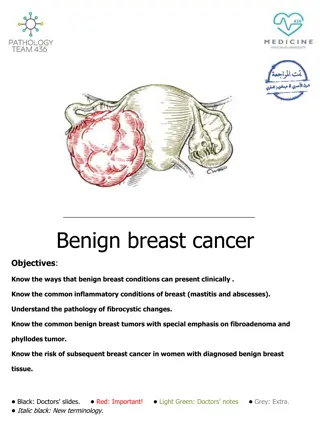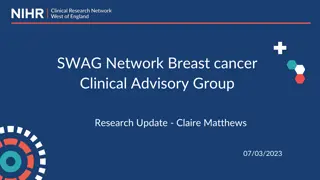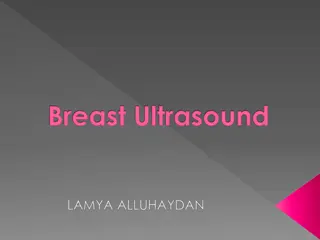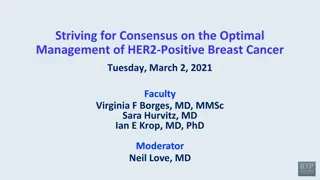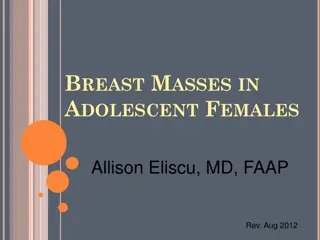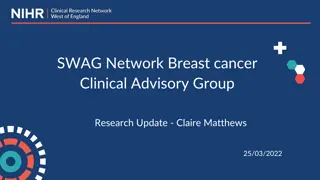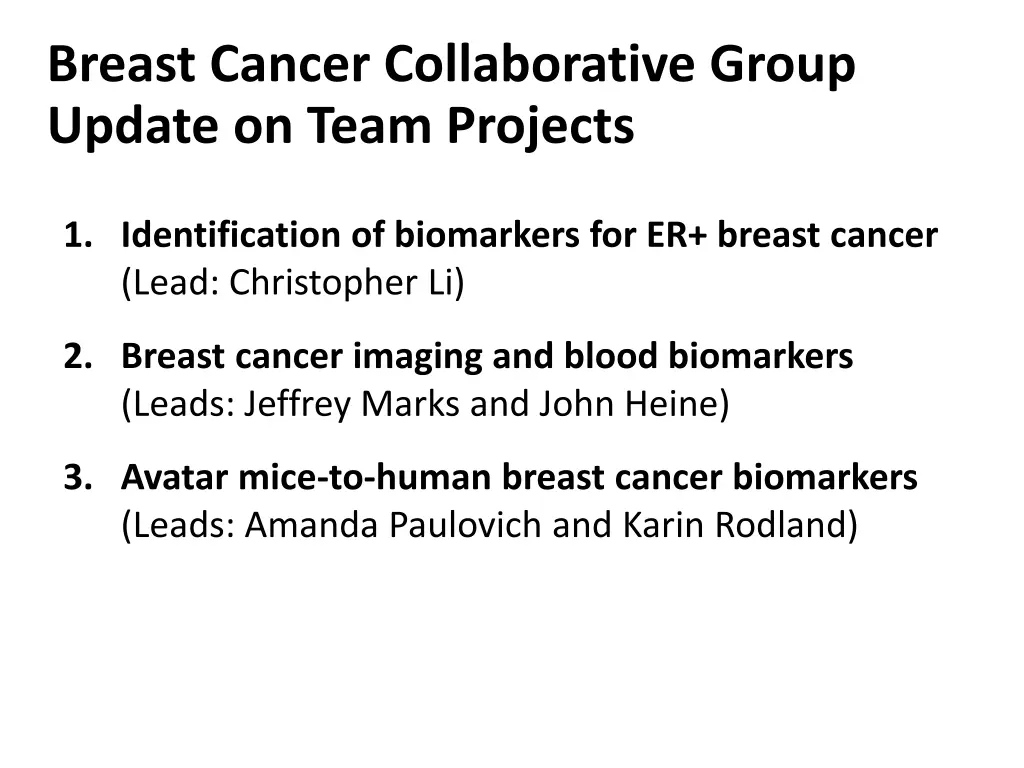
Breast Cancer Collaborative Group Update on Projects
Stay updated with the latest projects of the Breast Cancer Collaborative Group, including identification of biomarkers, imaging advancements, and potential clinical applications. Follow their progress in biomarker research and preclinical sample analysis for improved breast cancer detection and treatment.
Download Presentation

Please find below an Image/Link to download the presentation.
The content on the website is provided AS IS for your information and personal use only. It may not be sold, licensed, or shared on other websites without obtaining consent from the author. If you encounter any issues during the download, it is possible that the publisher has removed the file from their server.
You are allowed to download the files provided on this website for personal or commercial use, subject to the condition that they are used lawfully. All files are the property of their respective owners.
The content on the website is provided AS IS for your information and personal use only. It may not be sold, licensed, or shared on other websites without obtaining consent from the author.
E N D
Presentation Transcript
Breast Cancer Collaborative Group Update on Team Projects 1. Identification of biomarkers for ER+ breast cancer (Lead: Christopher Li) 2. Breast cancer imaging and blood biomarkers (Leads: Jeffrey Marks and John Heine) 3. Avatar mice-to-human breast cancer biomarkers (Leads: Amanda Paulovich and Karin Rodland)
Breast Cancer Collaborative Group Update on Team Projects 1. Identification of biomarkers for ER+ breast cancer (Lead: Christopher Li) 2. Breast cancer imaging and blood biomarkers (Leads: Jeffrey Marks and John Heine) 3. Avatar mice-to-human breast cancer biomarkers (Leads: Amanda Paulovich and Karin Rodland)
Potential Clinical Applications 1. Biomarkers to inform timing of subsequent screening in women who have had a negative mammogram: Goal: Identify markers that inform whether subsequent mammogram should occur in 6 months (early recall), 1 year, or 2 years 2.Biomarkers to inform continuation of mammographic screening among women 75-79 years of age: Goal: Identify women who have a 2-fold higher risk of developing breast cancer who may benefit from opting in for screening. 3. Identify high risk women who should be prioritized for screening in areas with limited resources/access to mammography Goal: Identify a subset of women 50-69 with a 2-fold higher risk of breast cancer who would particularly benefit from screening.
Work Flow Preclinical samples from postmenopausal women 50-79 recruited nationally Serial preclinical samples from women >65 recruited from 4 sites (CA, MD, NC, PA)
Timeline and Milestones (approved 3/2017) Months Milestone Status 0-12 Assessment and analysis of markers using the EDRN Reference Set Complete for FHCRC and ASU markers Lab work complete for FHCRC markers, analysis pending Plan developing for ASU markers 12-24 Assessment of top markers using WHI samples 24-36 Assay development/testing of top 10-15 markers using CHS samples Not started
Breast Cancer Collaborative Group Update on Team Projects 1. Identification of biomarkers for ER+ breast cancer (Lead: Christopher Li) 2. Breast cancer imaging and blood biomarkers (Leads: Jeffrey Marks and John Heine) 3. Avatar mice-to-human breast cancer biomarkers (Leads: Amanda Paulovich and Karin Rodland)
Purpose and Goal Breast cancer biopsy is performed routinely on a large number of women who have a low probability of cancer Goal is to improve predictive accuracy of mammography towards reducing the rate of biopsy by combining image analysis and blood based biomarkers Trying to achieve 98% NPV In conjunction with this project, the intent is to create a repository of images and matched blood for future studies
Cohorts Retrospective cohort of ~1000 images/blood (partially linked to existing breast cancer reference set at NCI- Frederick) Mostly Duke subjects given the blood repository Exclusively full field digital mammography (FFDM) Among other purposes, training of image analysis Prospective cohort of ~1000 images/blood Moffitt and Duke both FFDM and tomosynthesis CAML detection (Creatv MicroTech) can only be performed on freshly collected blood
Progress to Date Began Prospective Accrual at Duke in February Almost exclusively BI-RADS 4A and 4B 110 enrolled and analyzed for CAMLs Immunosignaturing performed on Stage I and benign conditions 330K peptide array Training and validation paradigm Multi-institutional training cohorts Independent analysis by ASU and IBM Blinded validation underway Moffitt IRB approved and began prospective accrual recently Four-way discussion for image storage and annotation Test images will be delivered to JPL this week
Breast Cancer Collaborative Group Update on Team Projects 1. Identification of biomarkers for ER+ breast cancer (Lead: Christopher Li) 2. Breast cancer imaging and blood biomarkers (Leads: Jeffrey Marks and John Heine) 3. Avatar mice-to-human breast cancer biomarkers (Leads: Amanda Paulovich and Karin Rodland)
Our clinical goal is to identify a blood-based biomarker that could be used in conjunction with mammography to improve sensitivity and specificity Limitations of Mammography Specificity of mammography for distinguishing benign vs. cancerous lesions Sensitivity of mammography in some patient populations (e.g. dense breasts) Over-diagnosis (e.g. some DCIS). This hypothetical biomarker would be impactful by detecting treatable cancers missed by mammography (mortality), and by allowing patients to avoid unnecessary procedures for benign disease (morbidity).
Human proteins are present in the plasma of mice harboring breast cancer xenografts. Human proteins are detected in the mouse plasma by mass spectrometry. mouse human-in-mouse breast cancer xenograft We hypothesize that a subset of the human tumor-derived proteins in the plasma of xenografted mice will be elevated in the plasma of women with breast cancer, and that a subset of these will be useful for early detection.
We pooled & analyzed the unlabeled, double-depleted plasma samples from 9 PDX mice for LC-MS/MS analysis. Data were stringently filtered to remove peptides mapping to spectra that gave IDs in both the mouse and human databases. PNNL 7,319 FHCRC 4,592 3,996 3,323 596 MS/MS search: MaxQuant human Uniprot db mouse Uniprot db Spectra filter 3,337 human peptides 951 human proteins!! 572 proteins (60%) have 2 unique peptides.
Although candidate proteins were enriched in breast cancer, none was observed exclusively in breast cancer. # of PDX proteins seen in all tumor samples Number of EDRN proteins (n=951) 74% of circulating proteins were seen in all CPTAC breast tumor samples, while only 25% were seen in all ovarian tumors, and 17% in all colon tumors. 800 700 600 500 400 300 200 100 0 Breast (n=108) Ovarian (n=84) CPTAC tumors Colon (n=95)
Next steps Perform additional due diligence to ensure these are really human proteins; consider analyzing normal mouse plasma. Attempt to replicate the results with an independent set of PDX mice. Consider enriching EVs from PDX and human plasmas for proteomic analyses. AIMS analyses to check for candidates in the plasma of human breast cancer patients. Further work on clarifying potential clinical applications and design of subsequent human validation studies.

